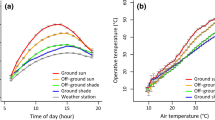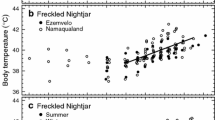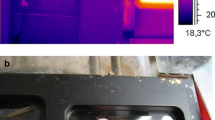Summary
The operative temperature of the environment was estimated for starlings using hollow, unheated taxidermic mounts. On average, adults foraging in full sun were characterized by shorter foraging bouts than those adults foraging in full shade. Simultaneous observations of air temperature, operative temperature, and the foraging duration of adults indicated that air temperature was a poor predictor of the maximum length of a foraging bout. The operative temperature of the environment was not correlated to the maximum and mean length of foraging bouts for temperatures below 31.5°C, but was negatively related to maximum and mean foraging duration for values above 31.5°C. I also found that foraging adults experiencing high thermal loads (T e≥31.5°C) were less likely to return to the nest with food. These results raise the possibility that adults may be limited in their utilization of foraging sites due to an inability to cope with heat load, and that much of the loafing behavior observed for breeding birds may be behavior to avoid heat stress. The implication for seasonal variation of clutch size is discussed.
Similar content being viewed by others
References
Bakken GS (1976) A heat transfer analysis of animals: unifying concepts and the application of metabolism chamber data to field ecology. J Theoret Biol 60:337–384
Bakken GS (1980) The use of standard operative temperature in the study of the thermal energetics of birds. Physiol Zool 53:108–119
Bakken GS, Buttemer WA, Dawson WR, Gates DM (1981) Heated taxidermic mounts: a means of measuring the standard operative temperature affecting small animals. Ecology 62:311–319
Balen JH van (1973) A comparative study of the breeding ecology of the Great Tit Parus major in different habitats. Ardea 61:1–93
Bennet A, Huey R, John-Ader H, Nagy K (1984) The parasol tail and thermoregulatory behavior of the Cape Ground Squirrel Xerus inauris. Physiol Zool 57:57–62
Breitenbach RP, Nagra CL, Meyer RK (1963) Effect of limited food intake on cyclic annual changes in Ring-necked Pheasant hens. J Wildlife Manage 27:24–36
Buttemer WA (1985) Energy relations of winter roost-site utilization by American goldfinches (Carduelis tristis). Oecologia (Berlin) 65:126–132
Chappell MA, Bartholomew GA (1981) Standard operative temperatures and thermal energetics of the antelope ground squirrel Ammospermophilus leucurus. Physiol Zool 54:81–93
Clark L (1983) Constraints on reproduction and parental care in the European starling. Doctoral Dissertation, University of Pennsylvania, Philadelphia
Clark L (1984) Consequences of homeothermic capacity of nestlings on parental care in the European starling. Oecologia (Berlin) 65:387–393
Crossner KA (1977) Natural selection and clutch size in the European starling. Ecology 58:885–892
Dmi'el R, Tel-Tzur D (1985) Heat balance of two starling species (Sturnus vulgaris and Onychognathus tristram) from temperate and desert habitats. J Comp Physiol 155B:195–402
DeWoskin R (1980) Heat exchange influence on foraging behavior of Zonotrichia flocks. Ecology 61:30–36
Gates DM (1981) Biophysical Ecology. Springer, New York
Goldstein D (1983) The effect of wind on avian metabolic rate with particular reference to Gambel's Quail. Physiol Zool 56:485–492
Goldstein D (1984) The thermal environment and its constraint on activity of desert quail in summer. Auk 101:542–550
Hart JS (1964) Seasonal acclimation in four species of small birds. Physiol Zool 35:224–236
Herbers JM (1981) Time resources and laziness in animals. Oecologia (Berlin) 49:252–262
Kelty MP, Lustick SI (1977) Energetics of the starling (Sturnus vulgaris) in a pine woods. Ecology 58:1181–1185
Kern MD, Van Riper III C (1984) Altitudinal variations in nests of the Hawaiian honeycreeper Hemignathus virens virens. Condor 86:443–454
King JR (1973) Energetics of reproduction in birds In: Farner DS (ed) Breeding biology of birds. National Academy of Sciences, Washington, DC, pp 78–120
King JR (1974) Seasonal allocation of time and energy resources in birds. In: Paynter RA, Jr (ed) Avian Energetics. Nuttall Ornithol Club 15:4–85
Klomp H (1970) The determination of clutch-size. A review. Ardea 58:1–124
Lack D (1948) Natural selection and family size in the Starling. Evolution 2:95–110
Lustick S, Battersby B, Kelty M (1979) Effects of insolation on juvenile Herring Gull energetics and behavior. Ecology 60:673–678
Perrins CM (1970) The timing of birds' breeding seasons Ibis 112:242–255
Pulliam HR, Anderson KA, Mistal A, Moor A (1974) Temperature-dependent social behavior in juncos. Ibis 116:360–364
Ray AA (1982) SAS User's Guide: Statistics. SAS Institute, Inc, Cary, North Carolina
Ricklefs RE (1974) Energetics of reproduction in birds. In: Paynter RA, Jr (ed) Avian Energetics. Nuttall Ornithol Club 15:152–297
Schmidt-Nielsen K (1983) Animal Physiology. Cambridge Univ Press, New York
Tinbergen JM (1976) How starlings (Sturnus vulgaris L) apportion their foraging time in a virtual single-prey situation on a meadow. Ardea 64:155–170
Tinbergen JM (1981) Foraging decisions in Starlings (Sturnus vulgaris L). Ardea 69:1–67
Torre-Bueno JR (1976a) Temperature regulation and heat dissipation during flight in birds. J exp Biol 65:471–482
Torre-Bueno JR (1976b) Evaporative cooling and water balance during flight inbirds. J exp Biol 75:231–236
Torre-Bueno JR, LaRochelle J (1978) The metabolic cost of flight in unrestrained birds. J exp Biol 75:223–229
Walsberg GE (1986) Thermal consequences of roost-site selection: the relative importance of three modes of heat conservation. Auk 103:1–7
Walsberg GE, King JR (1978) The heat budget of incubating mountain white-crowned sparrows (Zonotrichia leucophrys oriantha) in Oregon. Physiol Zool. 51:92–103
Author information
Authors and Affiliations
Rights and permissions
About this article
Cite this article
Clark, L. Thermal constraints on foraging in adult european starlings. Oecologia 71, 233–238 (1987). https://doi.org/10.1007/BF00377289
Received:
Issue Date:
DOI: https://doi.org/10.1007/BF00377289




